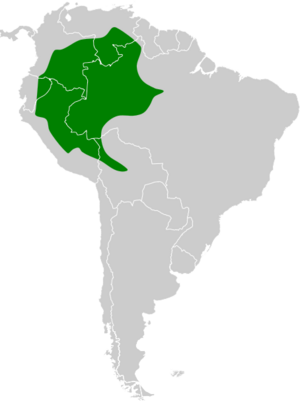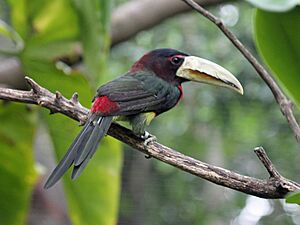Ivory-billed aracari facts for kids
Quick facts for kids Ivory-billed aracari |
|
|---|---|
 |
|
| At San Diego Zoo | |
| Conservation status | |
| Scientific classification | |
| Genus: |
Pteroglossus
|
| Species: |
azara
|
| Subspecies | |
|
See text |
|
 |
|
| Range of ivory-billed and brown-mandibled aracaris (see Taxonomy section) | |
| Synonyms | |
|
|
The ivory-billed aracari (Pteroglossus azara) is a colorful bird. It belongs to the toucan family, called Ramphastidae. You can find this bird in countries like Brazil, Colombia, Ecuador, Peru, and Venezuela.
Contents
Understanding the Ivory-billed Aracari: Taxonomy
Scientists often group animals based on how they are related. This is called taxonomy. The ivory-billed aracari is part of the toucan family.
Some scientists, like the International Ornithological Committee (IOC), say there are two types of this bird. These types are called subspecies. They are P. a. flavirostris and P. a. azara.
Other groups, like the American Ornithological Society, think there is a third subspecies, P. a. mariae. The IOC, however, sees P. a. mariae as a completely separate species, the brown-mandibled aracari.
Even though scientists have different ideas, all these types of aracaris can breed together where their homes overlap. The bird's scientific name, azara, honors a naturalist named Félix de Azara.
This article follows the idea that there are two subspecies.
What Does the Ivory-billed Aracari Look Like?

Imagine a bird about the size of a small crow. The ivory-billed aracari is about 36 to 45 centimeters (14 to 18 inches) long. It weighs around 120 to 160 grams (4 to 5.6 ounces).
Both male and female aracaris are similar in size and color. Adult males have a black cap on their head. Their head and throat are chestnut-colored. The back of their neck and upper back are maroon-red. Their lower back is green, and their rump is red.
Males also have a thin black band under their throat. They have a wide red band on their upper chest. Below that is a wide black band. Their belly is yellow, and their thighs are green.
Female aracaris look much like males. However, their cap is dark brown. The black band under their throat is also a bit thinner.
Bill Colors
The two subspecies have different bill colors. The P. a. azara subspecies has a mostly yellow bill. It has a deep red or brown line on its upper bill. This line is wide at the base and gets thinner towards the black tip. It also has red, black, and ivory marks along its edge that look like teeth.
The P. a. flavirostris subspecies has a yellow to ivory upper bill. It has an orange spot near its nostril. It also has black and white "teeth" marks. Its lower bill is yellow to ivory with a thin orange-brown line down the middle.
Where the Ivory-billed Aracari Lives: Distribution and Habitat
The P. a. azara subspecies lives in the Brazilian state of Amazonas. You can find it between the Rio Solimões (upper Amazon) and the Rio Negro rivers.
The P. a. flavirostris subspecies lives in southeastern Colombia, southern Venezuela, eastern Ecuador, northeastern Peru, and northwestern Brazil. Their homes sometimes overlap.
These birds live in many types of forests. They like varzea (flooded forests) and gallery forest (forests along rivers). They also live in secondary forest (forests that have grown back after being cut). You might also find them in bamboo forests or plantations.
They are more common in younger or middle-aged forests than in very old ones. They usually live below 600 meters (2,000 feet) in elevation. But sometimes they are found up to 900 meters (3,000 feet). In some areas, like near the Ecuador-Bolivia border, they can be found even higher.
Ivory-billed Aracari Behavior
Movement
The ivory-billed aracari is thought to live in the same area all year. It does not seem to migrate.
Feeding Habits
This bird looks for food in the upper parts of the forest and in the treetops. It usually forages in pairs or small groups. We don't know much about its diet. But it seems to eat mostly fruit. It also eats some arthropods (like insects or spiders).
Reproduction and Life Cycle
The breeding season for the ivory-billed aracari is usually from December to May. In some western and southwestern areas, it's from February to August.
Like other toucans, these birds are believed to nest in holes in trees. A female usually lays two to four eggs. Not much else is known about how they raise their young.
Vocalization
The song of the ivory-billed aracari sounds like a series of 2 to 6 wailing notes. These notes can be "twaaa-a-a," "tweee-ee," or "traaa-at."
They also make other sounds. These include rattles, grunt-like contact notes, and nasal "nyek" sounds. They can make purr-like notes, a "kyeek" alarm call, and pure rattles like "bddddt."
Status of the Ivory-billed Aracari
The IUCN (International Union for Conservation of Nature) is an organization that checks on animal populations. They do not look at the ivory-billed and brown-mandibled aracaris separately. They consider them as one group.
This combined group has a very large home range. Even though we don't know the exact number of birds, their population is thought to be stable. This means it's not going down.
Scientists have not found any immediate threats to these birds. They live in many different types of habitats. This suggests they are not likely to become endangered soon.


